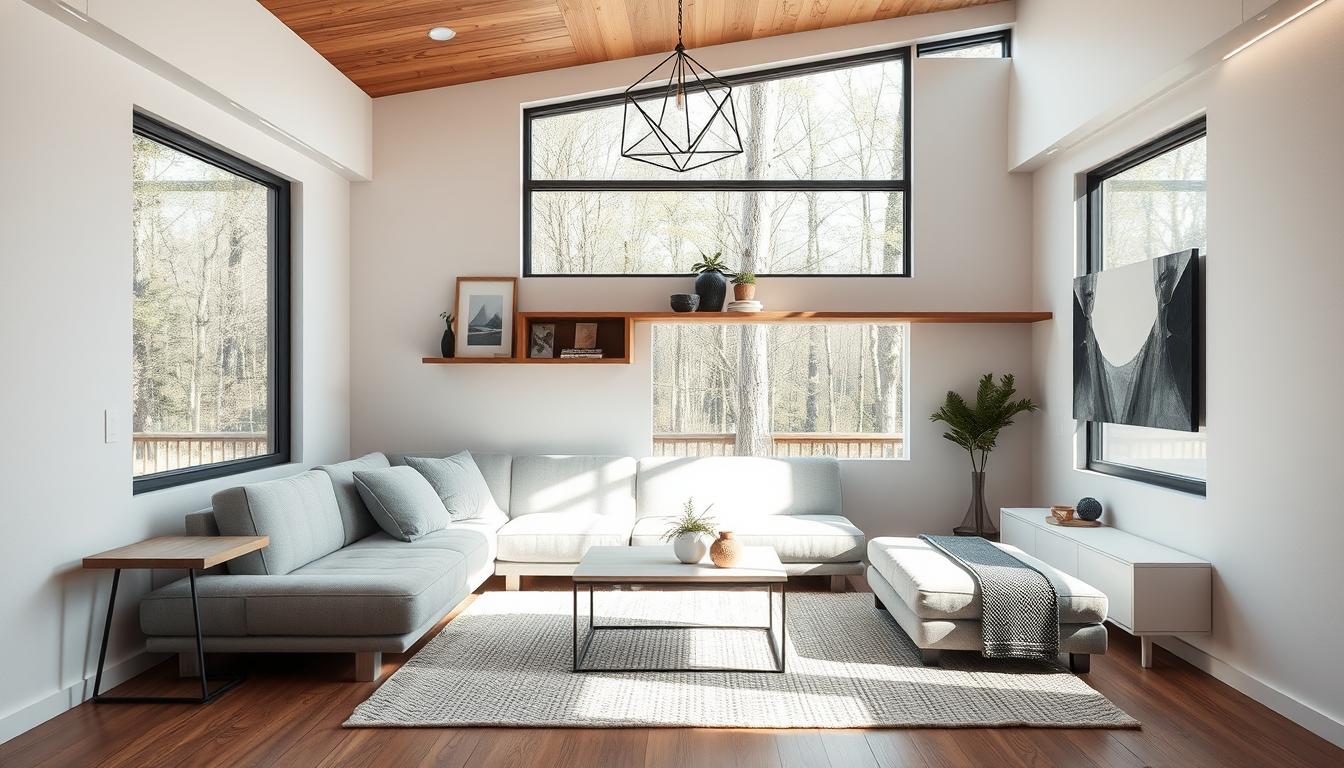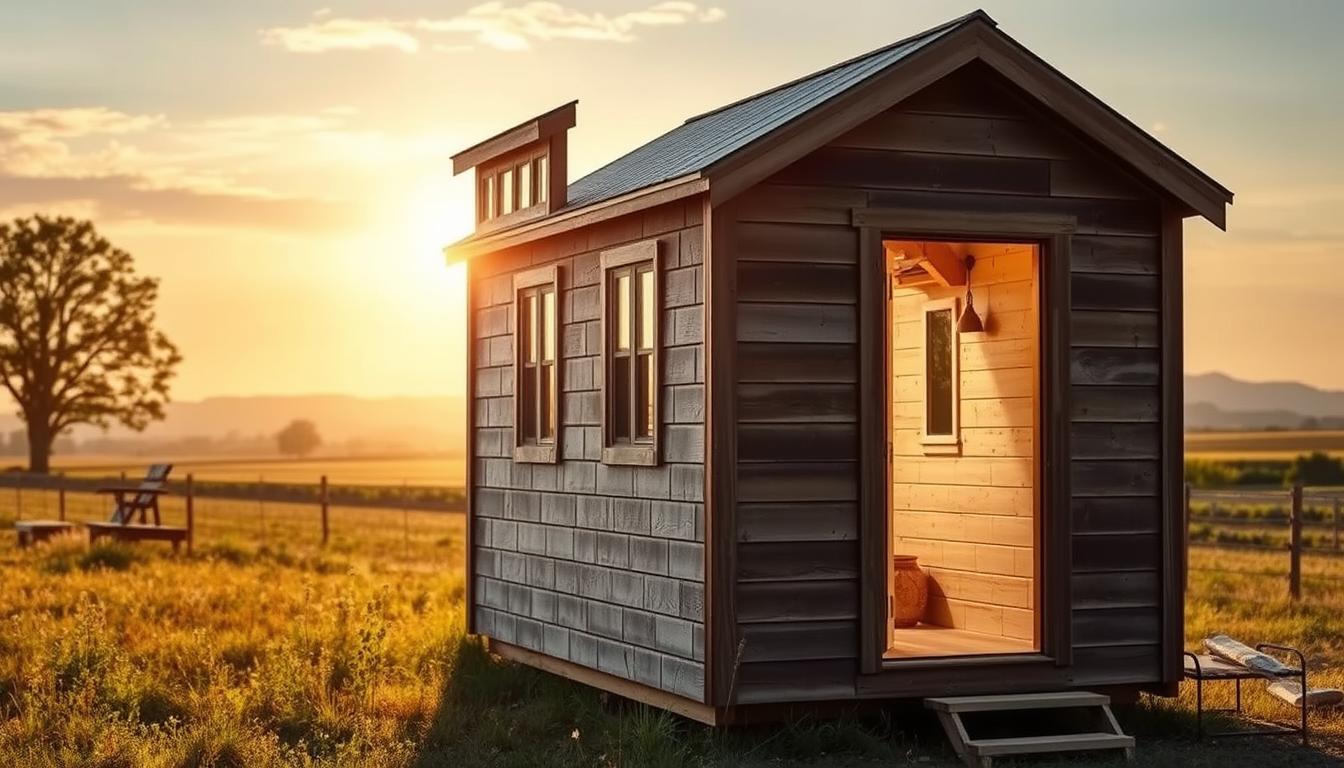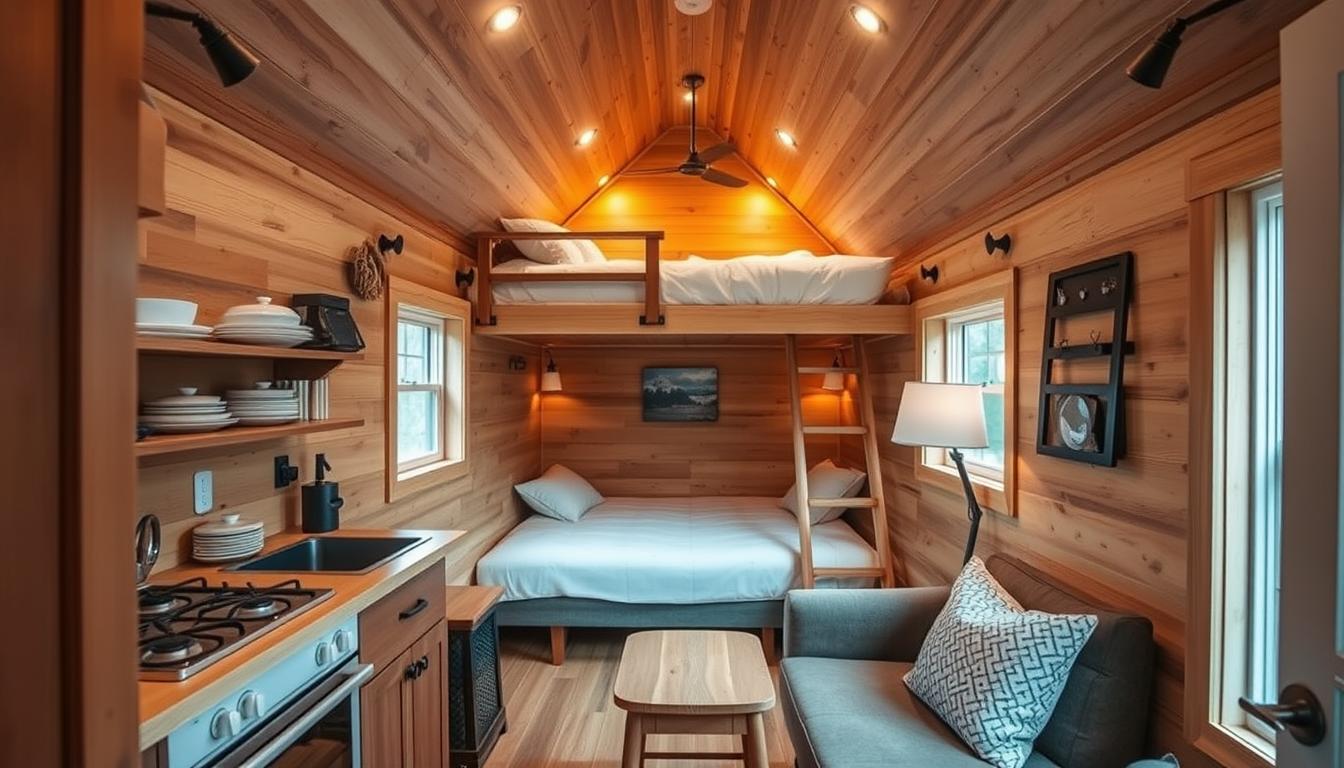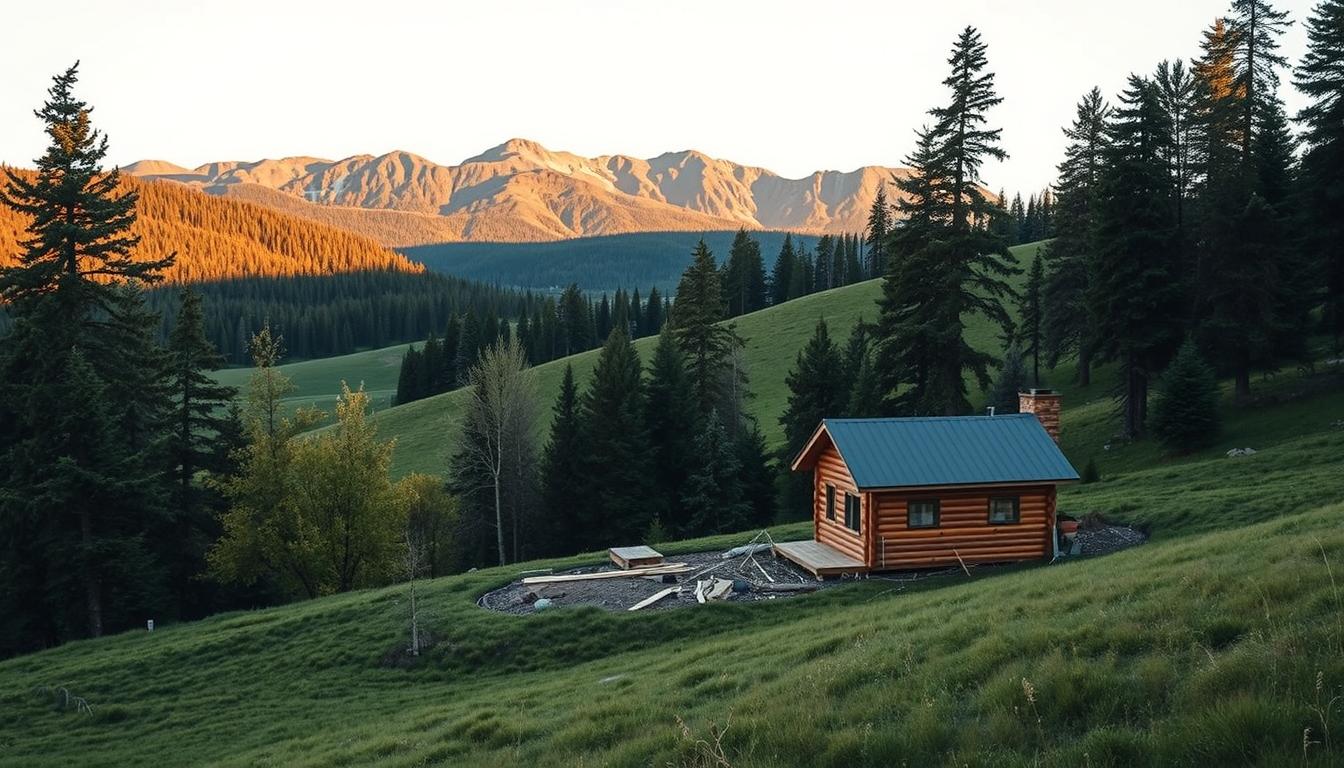What Will You Learn About Tiny Houses on Wheels?
- Definition and concept of a tiny house on wheels.
- Benefits and challenges of living in a tiny house on wheels.
- Factors to consider when finding and choosing the right trailer.
- Design considerations and construction methods for a mobile lifestyle.
- Permits, regulations, and zoning laws for tiny houses on wheels.
- Off-grid essentials and alternative utilities for a mobile lifestyle.
- Storage and organization tips for limited space in a tiny house on wheels.
- Tips for traveling with a tiny house on wheels.
- Maintenance and upkeep for a mobile home.
- Personal stories and case studies of living in tiny houses on wheels.
A. Definition and concept of a tiny house on wheels
A tiny house on wheels, also known as a THOW, is a compact and mobile living space that is typically built on a trailer or chassis. It offers all the amenities of a traditional home but in a much smaller footprint. The concept of a tiny house on wheels has gained popularity in recent years as people seek alternatives to conventional housing and embrace a more minimalist lifestyle.
B. Comparison to traditional tiny houses
While traditional tiny houses are built on a foundation and stationary, tiny houses on wheels provide the added benefit of mobility. They can be easily transported to different locations, allowing homeowners to change scenery and explore new areas without leaving their home behind. This flexibility is a significant advantage for those who value the freedom to travel and live in different places.
C. Exploring the benefits and challenges of living in a tiny house on wheels
Living in a tiny house on wheels offers a range of benefits. One of the most significant advantages is the ability to live a more sustainable and environmentally friendly lifestyle. Tiny houses on wheels typically require fewer resources to build and maintain compared to larger homes. They also have a smaller carbon footprint and can be designed to be energy-efficient.
Another benefit is the cost-effectiveness and affordability of tiny houses on wheels. They are often much cheaper to build or purchase compared to traditional housing. Additionally, the reduced living expenses associated with a smaller space can free up finances for other priorities or allow individuals to live debt-free.
However, living in a tiny house on wheels also presents its challenges. The limited space requires careful planning and organization to maximize functionality. Additionally, finding suitable parking spots and navigating local regulations and zoning laws can be complex. Despite these challenges, many people find the benefits of living in a tiny house on wheels far outweigh the drawbacks.
Why Choose a Tiny House on Wheels?
A. Mobility and flexibility in location
One of the primary reasons people choose a tiny house on wheels is the freedom to live and travel wherever they desire. Whether it’s exploring different regions or simply moving to a new neighborhood, a tiny house on wheels allows homeowners to easily relocate without the hassle of selling or renting out a property. This level of mobility is particularly appealing to individuals who enjoy a nomadic lifestyle or those who want to experience living in various environments.
B. Cost-effectiveness and affordability compared to traditional housing
Tiny houses on wheels are significantly more affordable than traditional homes. The cost of purchasing or building a tiny house on wheels can be a fraction of what it would cost to buy a traditional house. Additionally, the reduced size of a tiny house on wheels means lower utility bills and maintenance costs. This affordability can provide financial freedom and allow individuals to allocate their resources to other priorities, such as travel, education, or personal hobbies.
C. Minimal environmental footprint and sustainability
Living in a tiny house on wheels promotes a sustainable lifestyle. These homes are designed to be energy-efficient, with smaller heating and cooling requirements compared to larger houses. Additionally, the reduced square footage means fewer building materials are needed during construction. Many tiny house owners also incorporate eco-friendly features such as solar panels, rainwater collection systems, and composting toilets, further reducing their environmental impact.
D. Simplified and intentional living
The limited space in a tiny house on wheels necessitates a simplified and intentional lifestyle. With fewer possessions and a smaller living area, homeowners are encouraged to declutter and prioritize what is truly essential to them. This intentional living can lead to a sense of liberation and a focus on experiences rather than material possessions. Many people find that living in a tiny house on wheels allows them to prioritize relationships, personal growth, and the pursuit of their passions.

Finding and Choosing the Right Trailer
A. Importance of selecting the appropriate trailer for a tiny house on wheels
Choosing the right trailer is a crucial step in the construction of a tiny house on wheels. The trailer serves as the foundation and structural support for the entire home, so it’s essential to select one that is sturdy, reliable, and suitable for the specific requirements of your tiny house design.
B. Factors to consider: size, weight capacity, and towing requirements
When selecting a trailer, consider the size and weight capacity needed for your tiny house on wheels. The dimensions of the trailer should accommodate the layout and dimensions of your tiny house design. Additionally, ensure that the weight capacity of the trailer can support the weight of your fully constructed tiny house, including furnishings and appliances.
Towing requirements are another crucial consideration. Check the towing capacity of your vehicle and ensure it is compatible with the weight of your tiny house on wheels. It’s important to follow all safety guidelines and regulations for towing to ensure a smooth and secure transportation experience.
C. Understanding trailer classifications and options for different needs
There are various trailer classifications and options available for tiny houses on wheels. The most common types include utility trailers, flatbed trailers, and gooseneck trailers. Utility trailers are a popular choice for smaller tiny houses, while flatbed trailers provide more space for larger designs. Gooseneck trailers offer increased stability and maneuverability, making them suitable for larger tiny houses or those with specific design requirements.
It’s important to research and understand the different trailer options available to determine which one best suits your needs in terms of size, weight capacity, towing requirements, and overall design.
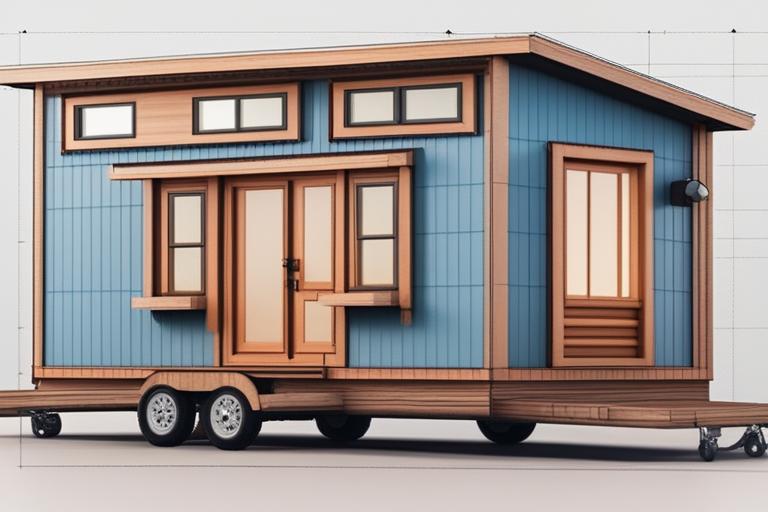
Designing and Building a Tiny House on Wheels
A. Space optimization and layout considerations for a mobile lifestyle
Designing a tiny house on wheels requires careful consideration of space optimization and layout. Every square inch counts in a tiny home, so it’s crucial to make the most efficient use of the available space. Consider multifunctional furniture, such as sofa beds or tables with built-in storage. Utilize vertical space with lofted sleeping areas or high shelves. Additionally, open floor plans can create a sense of spaciousness, while large windows provide ample natural light and a connection to the outdoor environment.
B. Materials and construction methods suitable for mobility and durability
When building a tiny house on wheels, it’s important to choose materials and construction methods that are durable and suitable for mobility. Opt for lightweight yet sturdy materials that can withstand the stresses of transportation. Common choices include steel or aluminum frames, lightweight insulation, and durable exterior cladding such as metal or composite materials.
C. Insulation and weatherproofing for different climates
Proper insulation and weatherproofing are essential for maintaining a comfortable living environment in a tiny house on wheels, regardless of the climate. Insulation helps regulate temperature and reduce energy consumption, while weatherproofing prevents leaks and drafts. Consider the specific climate and weather conditions of the areas you plan to travel to ensure your tiny house is appropriately insulated and weatherproofed.
D. Plumbing and electrical systems for a mobile lifestyle
The plumbing and electrical systems in a tiny house on wheels must be designed with mobility in mind. Flexible plumbing connections and compact fixtures are essential to minimize the risk of damage during transportation. Similarly, the electrical system should be properly wired and secured to prevent any issues while on the road. It’s important to consult with professionals or experienced builders to ensure the plumbing and electrical systems are installed correctly and meet all safety standards.

Permits, Regulations, and Zoning
A. Legal aspects of owning and living in a tiny house on wheels
Before embarking on the journey of owning and living in a tiny house on wheels, it’s important to understand the legal aspects and regulations involved. Tiny houses on wheels may be subject to different rules and regulations compared to traditional homes, as they are considered recreational vehicles or mobile dwellings in many jurisdictions.
B. Understanding permits, regulations, and zoning laws for tiny houses on wheels
Permitting requirements, regulations, and zoning laws vary from one location to another. Some areas may have specific regulations for tiny houses on wheels, while others may not allow them at all. It’s crucial to thoroughly research and understand the local regulations and zoning laws in the areas where you plan to live or travel with your tiny house on wheels.
C. Researching and navigating local regulations and finding suitable parking options
Researching and navigating local regulations is an essential step in finding suitable parking options for your tiny house on wheels. Some areas may have designated tiny house communities or RV parks that allow long-term or short-term stays. Other options include private land rentals, co-living arrangements, or even building a tiny house on wheels as an accessory dwelling unit on a traditional property. It’s important to explore all available options and ensure compliance with local regulations to avoid any legal issues.

Navigating Off-grid Living in a Tiny House on Wheels
A. Off-grid essentials for a mobile lifestyle
Living off-grid in a tiny house on wheels requires careful consideration and planning. Basic off-grid essentials include a reliable source of power, a water supply, and waste management solutions. It’s important to research and invest in appropriate systems and equipment to ensure a self-sufficient and sustainable lifestyle.
B. Solar power options and considerations for energy independence
Solar power is a popular choice for off-grid tiny houses on wheels. Installing solar panels on the roof can provide a reliable source of clean energy, allowing homeowners to power their appliances and electrical systems without relying on external power sources. When considering solar power options, it’s important to assess the energy requirements of your tiny house and determine the appropriate solar panel capacity and battery storage for your needs.
C. Water collection, filtration, and conservation techniques for self-sufficiency
Water collection, filtration, and conservation are essential for off-grid living. Rainwater collection systems can be installed to capture and store water for various uses, including drinking, cooking, and showering. Additionally, water filtration systems ensure the water is safe for consumption. Implementing water conservation techniques, such as low-flow fixtures and water-saving habits, can further reduce water consumption and increase self-sufficiency.
D. Waste management solutions for a tiny house on wheels
Proper waste management is crucial for maintaining a clean and sustainable living environment in a tiny house on wheels. Composting toilets are a popular choice for off-grid tiny houses, as they convert human waste into compost. Greywater systems can also be implemented to safely recycle and reuse water from sinks and showers. It’s important to research and understand the local regulations and best practices for waste management to ensure compliance and minimize environmental impact.
E. Alternative heating and cooling methods for off-grid living
Heating and cooling a tiny house on wheels off-grid requires alternative methods. Wood-burning stoves or compact propane heaters are commonly used for heating, while insulation and efficient windows help retain heat. For cooling, strategies such as natural ventilation, shading, and portable air conditioning units can be employed. It’s important to consider the specific climate and weather conditions of the areas you plan to travel to determine the most suitable heating and cooling methods for your tiny house on wheels.

Storage and Organization Tips for Tiny Houses on Wheels
A. Challenges and solutions for limited space in a mobile home
Limited space is one of the most significant challenges in a tiny house on wheels. However, with careful planning and creative solutions, it’s possible to overcome these challenges. Vertical storage, collapsible furniture, and built-in storage solutions can all help maximize space utilization. Additionally, decluttering regularly and adopting minimalist habits can prevent the accumulation of unnecessary items and maintain a clutter-free living environment.
B. Creative storage ideas and space-saving furniture for tiny houses on wheels
There are numerous creative storage ideas and space-saving furniture options available for tiny houses on wheels. Examples include hidden storage compartments under staircases or seating areas, wall-mounted fold-out tables, and lofted sleeping areas with built-in storage below. Custom furniture and storage solutions can be designed to fit specific dimensions and requirements, ensuring that every inch of space is utilized effectively.
C. Organization strategies for maintaining a clutter-free lifestyle
Maintaining organization is essential in a tiny house on wheels to maximize space and create a comfortable living environment. Adopting simple organization strategies can make a significant difference. Utilize storage bins and baskets to keep items organized and easily accessible. Implement a “one in, one out” rule to prevent unnecessary accumulation of belongings. Regularly declutter and reassess possessions to ensure they align with your needs and priorities. By adopting these organization strategies, you can create a clutter-free and serene living space.
Personal Story: Adventures on the Road
X. Personal Stories and Case Studies of Living in Tiny Houses on Wheels
As an advocate for the tiny house movement, I have had the pleasure of meeting and hearing the stories of many individuals and families who have chosen to embrace the lifestyle of living in a tiny house on wheels. One particular story that stands out is that of Sarah and Mark Thompson, a couple in their early thirties who decided to downsize and embark on a nomadic adventure.
Sarah and Mark had always dreamed of traveling and exploring different parts of the country, but the constraints of a traditional 9-to-5 job and mortgage payments made it seem like an impossible dream. That was until they discovered the world of tiny houses on wheels.
They spent months researching, planning, and designing their perfect tiny home. With careful consideration of their needs and desires, they built a cozy and functional space that allowed them to live comfortably on the road. They included a solar power system for energy independence, a water filtration system for sustainability, and plenty of storage solutions to make the most of their limited space.
Once their tiny house was complete, Sarah and Mark quit their jobs, sold most of their belongings, and hit the road. They started their journey by traveling along the East Coast, exploring national parks, charming small towns, and breathtaking landscapes. With their tiny house on wheels, they had the freedom to stay in each location for as long or as little as they wanted, immersing themselves in the local culture and enjoying the beauty of nature.
Throughout their travels, Sarah and Mark faced challenges, such as finding suitable parking options and securing their belongings during transit. However, they quickly learned to adapt and problem-solve, finding creative solutions along the way. They connected with other tiny house dwellers through online communities and shared their experiences, providing support and inspiration to others who were considering a similar lifestyle.
Their journey has not only been a source of adventure and exploration but also a transformative experience. Living in a tiny house on wheels has allowed Sarah and Mark to simplify their lives, focus on experiences rather than possessions, and cultivate a deeper connection with the world around them. It has given them the opportunity to break free from the societal norms and expectations, and to create a life that aligns with their values and dreams.
Sarah and Mark’s story is just one of the many personal narratives that highlight the joys and challenges of living in a tiny house on wheels. Each story is unique, offering valuable insights and perspectives on this alternative way of living. Whether it’s the sense of freedom and mobility, the financial benefits, or the opportunity to live more sustainably, these personal stories demonstrate that a tiny house on wheels can truly be the gateway to a life of adventure and fulfillment.
Tips for Traveling with a Tiny House on Wheels
A. Ensuring road safety while towing a tiny house on wheels
Towing a tiny house on wheels requires adherence to road safety guidelines to ensure a smooth and secure journey. It’s essential to understand the weight limits and towing capacity of your vehicle and trailer combination. Properly distribute the weight of your tiny house to maintain stability on the road. Additionally, regular maintenance and inspections of the towing vehicle, trailer, and hitch are crucial for safe travels.
B. Securing belongings during transit for a smooth journey
Securing belongings inside the tiny house is imperative to prevent damage during transit. Use straps or bungee cords to secure furniture, appliances, and other loose items. Install latches or locks on cabinets and drawers to prevent them from opening during travel. It’s also important to secure any external features, such as awnings or solar panels, to avoid damage from wind or road vibrations.
C. Finding suitable campsites and parking options for tiny houses on wheels
Finding suitable campsites and parking options is essential for travelers with a tiny house on wheels. Many RV parks and campgrounds welcome tiny houses on wheels, providing amenities such as electrical hookups and waste disposal facilities. Some national and state parks also offer designated areas for tiny houses on wheels. Additionally, there are online resources and communities where tiny house owners share information and recommendations on suitable parking options.
D. Connecting to utilities while on the move and staying comfortable
While traveling with a tiny house on wheels, it’s important to ensure access to necessary utilities and maintain a comfortable living environment. Electrical hookups at RV parks or campsites can provide a reliable power source. For water supply, consider carrying a portable water tank or utilizing on-site water hookups. Propane or alternative heating methods can provide warmth during colder months, and portable air conditioning units or natural ventilation can help keep the interior cool in warmer climates. With careful planning and preparation, you can enjoy a comfortable and self-sufficient lifestyle while on the move.
William is a renowned architect and sustainability advocate with over 15 years of experience in the field. She holds a Master’s degree in Architecture from a prestigious university and has worked on numerous innovative projects focused on sustainable and compact living.
Throughout her career, William has extensively researched and designed smaller living spaces, including tiny houses on wheels. Her expertise in this area is backed by her involvement in various case studies and personal stories of individuals who have embraced the tiny house movement.
William is passionate about promoting sustainable and minimalistic living and has been a frequent speaker at conferences and workshops on the subject. Her knowledge and insights into the challenges and benefits of living in a tiny house on wheels make her a trusted source of information.
In addition to her professional achievements, William has personally lived in a tiny house on wheels for several months, traveling across the country and documenting her experiences. This firsthand knowledge adds depth and authenticity to her writing, providing readers with valuable advice and practical tips for embracing compact living.





